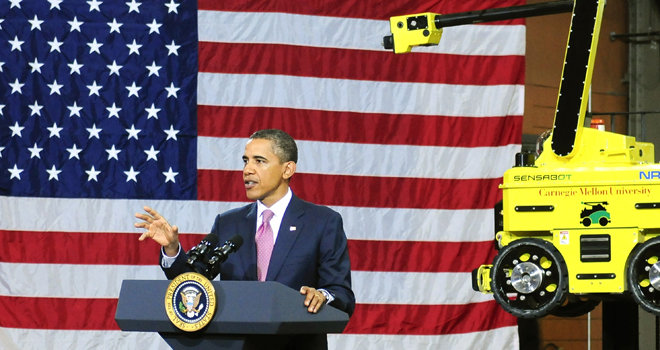President Obama launched a new federal initiative on Friday designed to stem the United States’ precipitous decline in manufacturing.
The Advanced Manufacturing Partnership initiative calls for a partnership between the federal government and private industry to develop key areas of emerging technologies that would make the U.S. environment more competitive and friendly to manufacturers.
The idea is to speed up the development of promising areas of technologies like advanced robotics, nanoelectronics and new kinds of materials needed by industry so that manufacturers can use these emerging technologies as tools to help them to make their products better and faster.
Nanoelectronics, which are expected to replace silicon chips as the next generation of semiconductors, are one area that the administration has identified as an area that’s ripe for collaboration. Its successful and speedy development could result in different kinds of computing devices the development of chemical and biological sensors, fuel cells, and lightweight body armor, among other things.
Flexible electronics, next-generation optoelectronics, biotechnology and biomanufacturing were other areas where the government could step in to help.
“The invention of silicon circuits and lithium-ion batteries made computers and iPods and iPads awesome, but it took years to get those technologies to the drawing board and into the marketplace — we can do it faster,” Obama said in a speech describing the initiative on Friday at Carnegie Mellon University, where he toured a robotics laboratory.
“This partnership is about new, cutting-edge ideas to create new jobs, spur new breakthroughs, reinvigorate American manufacturing today, right now – not somewhere off in the future,” he said. “It’s about making sure that our workers and businesses have the tools and the skills to compete better, faster and smarter than anybody else.”
A past success story of federal funding that resulted in a great company is Google, since it sprang up out of a grant from the National Science Foundation.
This advanced manufacturing initiative aims to fund broad developments and enabling technologies that private industry wouldn’t finance by themselves.
The plan, which still has to be approved by congressional appropriators, calls for an initial $500 million round of funding for 2012, and ramps up to $1 billion in its fourth year.
The initiative is part of an attempt to reverse the decline of manufacturing in the United States. Other parts include a revamp of U.S. tax policy, immigration reform and workforce development.
Manufacturing jobs are being lost to “high-wage” countries like Germany and Japan, and not just to lower-cost countries, said Eric Lander, a co-chair of the President’s Council of Advisors on Science and Technology, more commonly known as PCAST.
The manufacturing initiative is a result of months of the council’s work. Shirley Ann Jackson, president of the Rensselaer Polytechnic Institute in Troy, N.Y., co-chairs the council and worked on the report that lays out the roadmap and rationale for the initiative. Lander is a biology professor at MIT.
The council rolled out many statistics to emphasize the US’ manufacturing decline. It’s not just in the field of making plastic flowers and Mickey Mouse toys, but also highly complex products.
It noted that some economists have said that China overtook the United States in 2010 as the world’s leading manufacturer.
This kind of initiative, which the administration is calling its innovation policy, isn’t unprecedented, and it took its inspiration from a prior initiative in the late 1980s.
The U.S. government’s Defense Advanced Research Project Agency partnered back then with 14 semiconductor manufacturers to overcome common manufacturing problems when it looked as if Japan was going to dominate the market.
It’s important to stay competitive in manufacturing because that’s where a lot of new research, ideas and knowledge emerge, said the authors of the PCAST report. It’s also a matter of national security, they noted — it’s important to be able to know how to make our own stuff.
They point to a laundry list of technologies that were invented in the U.S., but that are now mostly made abroad:
Laptop computers
Solar Cells
Semiconductor memory devices
Flat panel displays
Robotics
Interactive electronic games
Lithium-ion batteries
If the trends in manufacturing and research and development continue unchecked, the academics and industry leaders worry that it is “increasingly possible to imagine that the United States might be shut out from competing altogether in certain industries as knowledge and inventions are increasingly produced abroad in addition to the products that result from them.”






